What did you expect would happen if you left a roomful of Rotax engineers and motorcycle/snowmobile nuts cooped up for a few winters in Canada? The Can-Am Spyder, now entering its fifth year of production, is simply another example of mechanical evolution at work. When Piaggio bought Aprilia and decided to produce its own engines, it left Rotax with the already well-developed and reliable "990" engine that had powered the Aprilia Caponord/Futura bikes (a midrangier version of the V-Twin from the RSV1000). And Rotax is owned by Bombardier Racing Products.
BRP launched its first “Ski Dog” snowmobile in 1959 with a too-artistic font. Its sleds have been “Ski Doo” ever since, and it’s cranked out a bunch of them from its Valcourt, Quebec, HQ. Not to mention a line of Can-Am ATVs and side-by-sides, Sea-Doo pond swizzles and boats, and don’t forget the Can-Am dirt bike from the ’70s. This is not BRP’s first rodeo, though the Spyder is the company’s first on-road vehicle.
As a matter of fact, the Spyder concept began life as a snowmobile you could ride year-round in northern climes, with a wheel in back instead of a track, but everybody had so much fun riding the thing around it occurred to BRP it might be able to create an entirely new class of vehicle the whole world could enjoy, which is exactly what the Spyder pretty much is.
Though it looks like a sled, the main frame is more like the box-section steel one you'll find in an ATV, with double A-arm suspension up front, a long motorcycle swingarm out back, and belt drive to the rear wheel. The engine is where you'd expect under the gas tank. There was trouble, though, and that was caused by people having a little too much fun on the Spyder: With all the traction of a sports car up front but the traction of only half a sports car out back, you could drive the Spyder into corners with a level of enthusiasm not necessarily shared by its rear end at the exits. Which might then invoke the laws of physics to slide out, then grip again, with dangerous and painful results.
What makes the Spyder possible and therefore marketable is modern electronics in the form of its Vehicle Stability System, developed by Bosch. You got your Stability Control System, which applies a little brake to the outside front wheel when it senses the inside wheel’s going to lift. (You can lift it a little anyway if you turn in quick enough, or a lot if you’re Cernicky). You got your Traction Control System, which tempers the baser instincts of your right wrist at corner exits by cutting engine output as it sees fit. And you’ve got your ABS on all three wheels.
I have no beef with SCS, which feels like you're scrubbing off speed with the front tires as you dive into tight corners. ABS is always a good thing in my book, at least when it comes to pavement. But I do have a problem with TCS as it's applied to the Spyders. All three of them, RSS, RS and RT, have VSS but with slightly different tuning. On a swervy road, when you're past the apex of a corner and (mostly) pointed down the next straight, TCS turns into an overprotective mother that refuses to relinquish authority right when you most want to gas the Spyder hard. Twisting the grip gets you a big buh-buh-buh, nothing until the rear wheel isn't sliding at all. During development, when you could turn the system on and off, it was called "the nun switch."
But that’s electronics, which surely can be fine-tuned once you’ve bought the thing. Well, nobody’s done it yet that I can find. Aside from the far-too-intrusive TCS, I had more fun riding the Spyders than I thought I would as I sorted through which muscle memories to mix and match. In corners, you weight the outside peg like cornering a dirtbike. You push on the outside bar to turn/scrub speed, variable-boost electric power steering makes it easy. But you want to hang off the inside of the thing like a sidecar monkey. Tight corners are a hoot with all that contact patch up front, and in a couple of them I closed my eyes for the inevitable spin that never came. The SCS is pretty dang effective. Fast sweepers are interesting as you feel the rear wheel getting light and sense the electronic nun waiting to slap the outside front brake with a ruler. At speed on the big RT touring version, with its full-coverage electric windshield and plush cockpit, you feel like an Airbus captain on autopilot. Seems like there should be a seatbelt.
For 2012, Can-Am serves up four RT touring models—ranging from the $21,699 5-speed manual base model to the $28,899 Spyder RT Limited. All of them get cruise control, heated grips and 41 gallons of storage capacity—and the full-boat Limited gets all sorts of luxury touches, an excellent paddle-shift automatic gearbox, electric-adjust rear suspension, upgraded iPod-compatible radio and a Garmin 660 GPS. At that point, you're pushing 929 pounds (before you add 6.6 gallons of fuel) with the 998cc V-Twin, which Can-Am rates at 80 foot-pounds of torque at 5000 rpm. It scoots, but it's no Gold Wing.
The sportier Spyder RS starts at $16,499 for a 5-speed manual, and ranges up to $18,099 for the sportiest RS-S—now with gas-charged Fox shocks up front, six-spoke front wheels, paddle-shift automatic 5-speed transmission and cool two-tone metallic paint options.
Can-Am’s research tells it there are many people out there who want the wind-in-the-face experience, but not necessarily the gravel-in-the-ass one now that they’re predominantly 45- to 55-year-old males, 27 percent of whom have never owned a motorcycle. Another interesting fact is that 25 percent of owners are women. Let’s face it. Many of us are more risk averse than we once were. It’s called wisdom. Also, in many parts of the world, obtaining a license to ride a Spyder is far less involved than getting a motorcycle license. In California, all you need is a car license. The main drawback of the Spyder out here is it can’t lane-split, but it can ride in the car pool lane. Everywhere else, it’s almost a motorcycle you can’t fall off of.










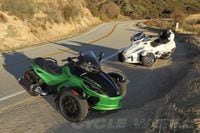
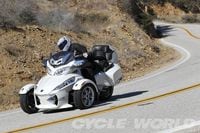
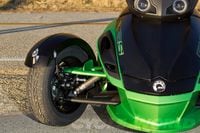
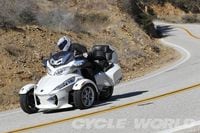
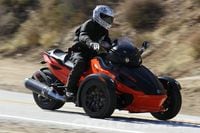
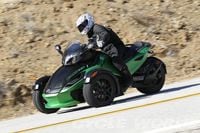
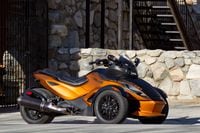
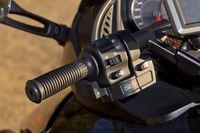
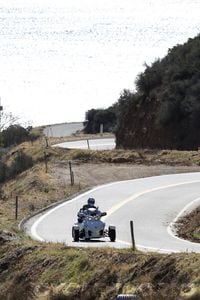
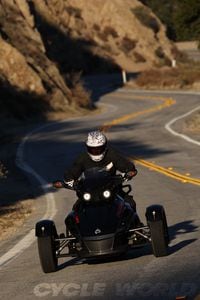
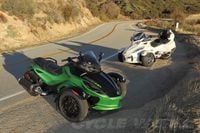
/cloudfront-us-east-1.images.arcpublishing.com/octane/AUE3NFVRRZDSBIDVUGIYIDQNUI.jpg)
/cloudfront-us-east-1.images.arcpublishing.com/octane/LYR62CH2WNBMHJJVXVATZHOUE4.jpg)
/cloudfront-us-east-1.images.arcpublishing.com/octane/RBCTRGBQYBDK7A6XPG3HKPS7ZQ.jpg)
/cloudfront-us-east-1.images.arcpublishing.com/octane/MQXQRYMZVBCWJIRYP3HEN3SHVE.jpg)
/cloudfront-us-east-1.images.arcpublishing.com/octane/TSPODNNEWRDSVJGUCNQTDG4ADI.jpg)
/cloudfront-us-east-1.images.arcpublishing.com/octane/X5TB7BDV4BA2RPSY54ZGK27RP4.jpg)
/cloudfront-us-east-1.images.arcpublishing.com/octane/REUHOJXRDBGZ5IHBYZCCBCISPA.jpg)
/cloudfront-us-east-1.images.arcpublishing.com/octane/52LGJTCKBFEHDF7S7H4CVUIMGM.jpg)
/cloudfront-us-east-1.images.arcpublishing.com/octane/YMWAIPIPSJAOXOU3QMJMGH37OM.jpg)


/cloudfront-us-east-1.images.arcpublishing.com/octane/EJ6KZRGAYBCVXNL2PJXL37UVWQ.jpg)
/cloudfront-us-east-1.images.arcpublishing.com/octane/AAN4TI76M5H5JMUVEIGASWXBDU.jpg)
/cloudfront-us-east-1.images.arcpublishing.com/octane/P3RXD2UCPFF37CMB7CHPVKXORY.jpg)
/cloudfront-us-east-1.images.arcpublishing.com/octane/VZEG2EJI2RDFZNHLRZMU56MD3Q.jpg)
/cloudfront-us-east-1.images.arcpublishing.com/octane/GVJQO5FFOFBWNGODOBRB4FBAW4.jpg)
/cloudfront-us-east-1.images.arcpublishing.com/octane/BIVAK2SFIBDJJM25E7I5VU2FJE.jpg)
/cloudfront-us-east-1.images.arcpublishing.com/octane/CH5VX52UG5CFHOVH5A6UYEFWWA.jpg)
/cloudfront-us-east-1.images.arcpublishing.com/octane/ZVGJNGZRU5C33N7KN23BBFKSC4.jpg)

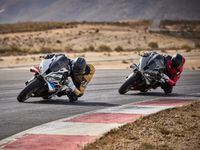
/cloudfront-us-east-1.images.arcpublishing.com/octane/CZ5OM3E43ZEXJHY7LCYXCHLIKI.jpg)
/cloudfront-us-east-1.images.arcpublishing.com/octane/DF5T4K5KPZFJXFCTGPYR77PKJM.jpg)
/cloudfront-us-east-1.images.arcpublishing.com/octane/RMCT2KVQBJHBZMRTSLOVPMOILU.jpg)